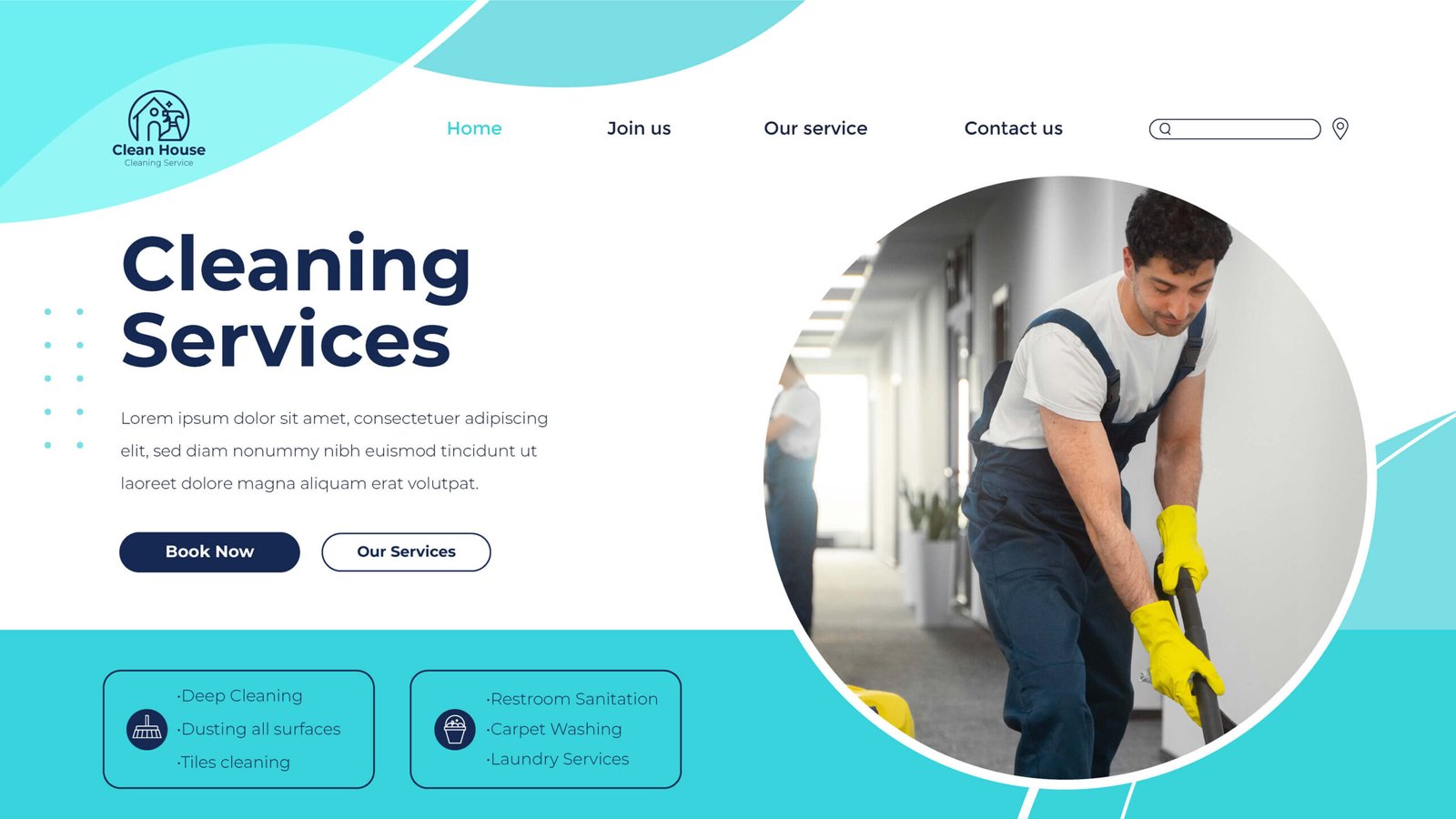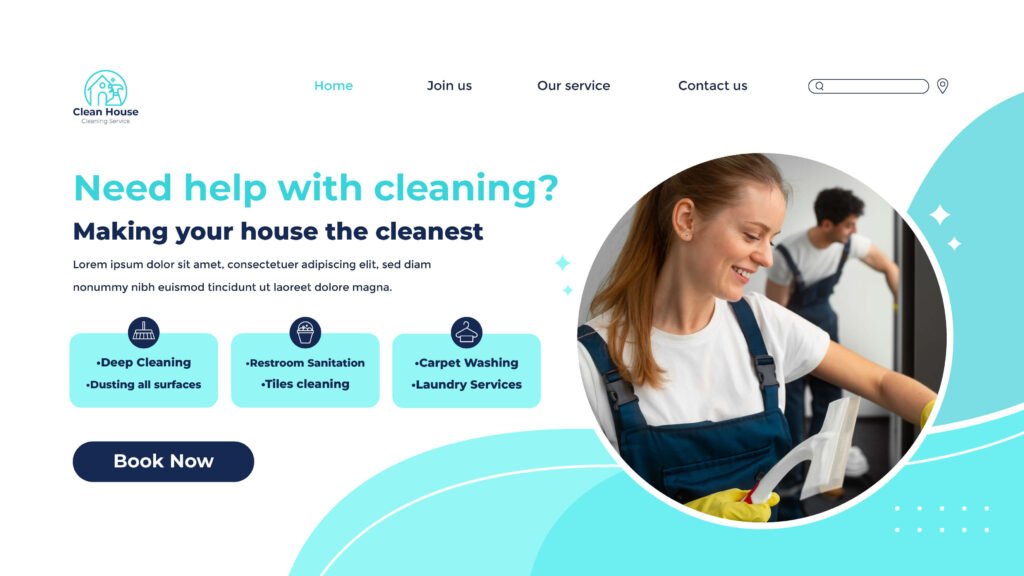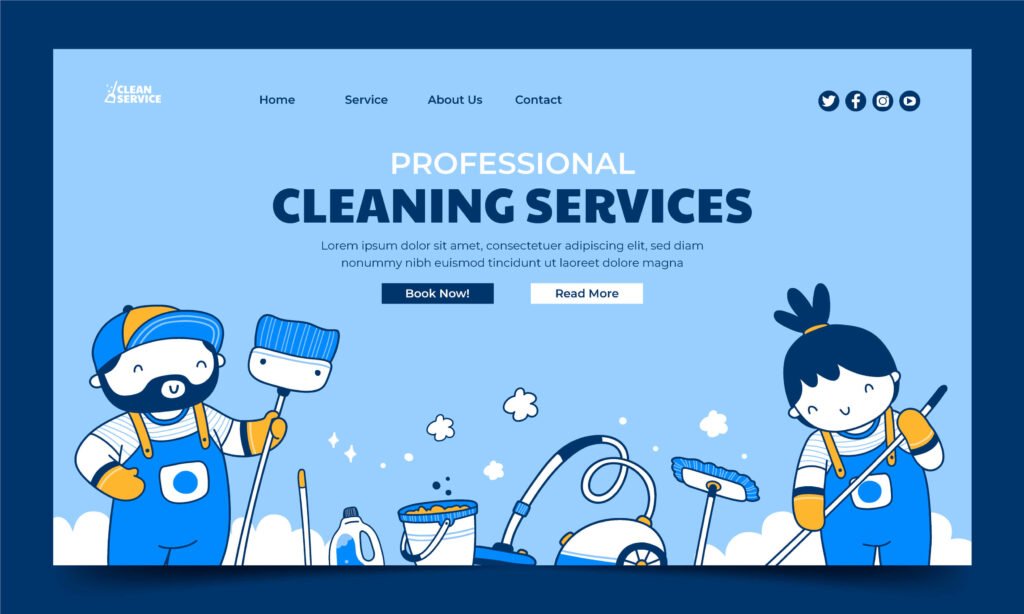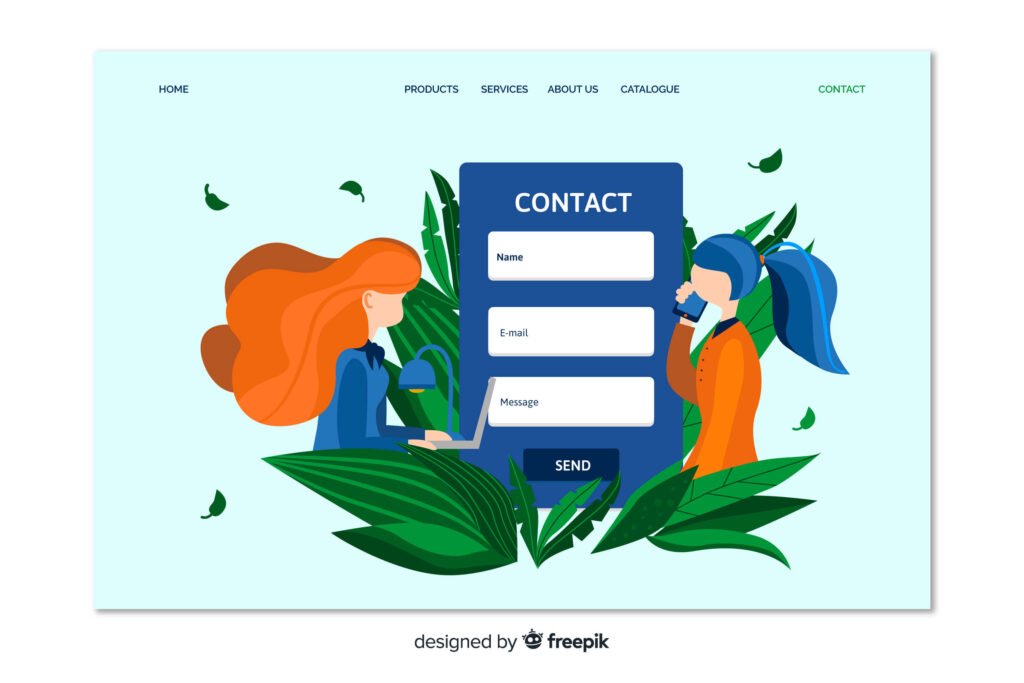
Are you wondering how to create a cleaning website but don’t know where to start? Whether you’re starting a residential cleaning service, a commercial janitorial company, or a niche window-cleaning business, having a professional website is a must. In today’s digital age, your website acts as your online storefront it’s where potential clients learn about your services, check your prices, and even book appointments.
In this comprehensive guide, we’ll walk you through everything you need to know to build a successful cleaning website from scratch. You don’t need to be a tech expert to follow along this article is written for beginners and small business owners.
Table of Contents
Why You Need a Cleaning Website: how to create a cleaning website?

In today’s digital-first world, if your cleaning business isn’t online, it might as well not exist. Whether you’re running a residential maid service, a commercial janitorial business, or a specialty cleaning company (like carpets or windows), having a professional website is no longer optional it’s essential.
Here’s why creating a cleaning website is one of the smartest decisions you can make:
1. Builds Trust and Credibility
When someone searches for cleaning services in your area, the first place they look is online. If you don’t have a website, you instantly lose credibility. On the other hand, a well-designed website with clear service descriptions, client testimonials, and a professional look makes your business appear trustworthy and legitimate.
A website tells your customers:
- “We’re a real business.”
- “We take our work seriously.”
- “You can trust us in your home or office.”
In industries like cleaning—where trust and reputation are everything—this matters more than you might think.
2. Attracts New Customers 24/7
Unlike a storefront or phone line that might close at 5 p.m., your website works for you around the clock. It can attract visitors and generate leads even while you sleep. Whether someone’s browsing at midnight or early in the morning, your website is always available to:
- Explain what you do
- List your pricing and packages
- Allow them to book or contact you
It’s like having a full-time salesperson online, working without breaks or vacation.
3. Expands Your Local Reach
A good cleaning website helps you reach more potential clients in your target area. By using local SEO strategies, such as adding your city or suburb to your keywords (e.g., “House Cleaning in Johannesburg”), you can show up when people search for cleaning services nearby.
Google Maps, local directories, and review platforms like Yelp all connect better with businesses that have an actual website linked to their profile.
4. Allows You to Showcase Your Work
You can use your website to display:
- Before-and-after photos
- Team member profiles
- Customer testimonials
- Certifications or licenses
This content not only builds trust but also helps potential clients visualize the value of your service. You can even include short videos to give a personal touch or explain how your process works.
5. Makes Booking Services Easier
A major benefit of having a website is that it allows clients to book your services online without needing to call. Many cleaning businesses integrate:
- Booking forms
- Instant quote calculators
- Live chat or WhatsApp plugins
This makes the process easier for the customer and more efficient for you, saving time and reducing no-shows.
6. Collects Important Data for Growth
Your website can be connected to tools like Google Analytics, which show you:
- How many people visit your site
- Which pages they look at
- How they found you (Google, Facebook, etc.)
- What services interest them most
This data can help you fine-tune your services, promotions, and content based on actual user behavior. It also helps guide your marketing spend more effectively.
7. Keeps You Competitive
Chances are, other cleaning businesses in your area already have websites. If you don’t have one, you’re falling behind. A professional website helps you stand out with:
- A clean design
- Great user experience
- Detailed service information
- Quick contact options
It gives you a competitive edge, especially if your competitors haven’t invested in a user-friendly or mobile-optimized site.
8. Supports Online Advertising and Marketing
If you ever want to run Google Ads or Facebook promotions, a website is essential. Ad platforms require a landing page where users are directed after clicking an ad. Without a site, you miss the opportunity to capture leads from paid traffic or retarget interested visitors.
A cleaning website also allows you to:
- Build an email list
- Offer coupons or discounts
- Run seasonal promotions (e.g., spring cleaning specials)
9. Provides a Central Hub for Your Brand
Think of your website as the hub of your online presence. Everything you do online—social media, directories, email marketing—should lead back to your website. It acts as your:
- Digital portfolio
- Booking platform
- Pricing guide
- Contact center
- Brand showcase
As you grow, your website can grow with you—adding team bios, customer portals, service areas, blog articles, or even payment options.
10. Saves You Time and Streamlines Operations
With the right setup, your cleaning website can automate tasks like:
- Sending confirmation emails
- Scheduling appointments
- Answering common questions via FAQ sections or chatbots
This allows you and your team to spend more time cleaning and less time handling administrative tasks.
Final Thoughts
A cleaning website isn’t just a nice-to-have; it’s a must-have tool for modern success. It positions you as a professional, builds trust with your clients, and helps grow your business more efficiently. Whether you’re just starting out or have been in the industry for years, investing time into a well-designed website is one of the best ways to stand out in the competitive cleaning market.
Up next, we’ll show you exactly how to get started—step by step.
Step 1: Choose a Domain Name
Your domain name is your website address—like www.sparklecleaning.com. Here’s how to choose a great one:
- Keep it short, memorable, and easy to spell.
- Use your brand name (e.g., “SunshineCleaners”).
- Add your niche or location if needed (e.g., “DenverMaidService.com”).
You can purchase a domain from sites like:
- Namecheap
- GoDaddy
- Google Domains
Expect to pay $10–$15 per year.
Step 2: Pick a Reliable Web Hosting Provider
Web hosting is where your website lives online. Choose a hosting provider that’s:
- Fast and secure
- Has 24/7 customer support
- Offers 1-click WordPress installation
Recommended beginner-friendly hosts:
- Bluehost – Great for beginners
- Hostinger – Affordable and fast
- SiteGround – Reliable and scalable
Most plans start around $2.95–$5.95/month.
Step 3: Install a Website Builder (Like WordPress)
If you’re not a web developer, using a website builder like WordPress is your best bet.
Why WordPress?
- Free and open-source
- Easy to use
- Thousands of templates and plugins
Most hosting providers offer 1-click WordPress installation. Once installed, you can log into your dashboard (e.g., yourwebsite.com/wp-admin) and begin editing your site.
Step 4: Choose a Cleaning Business Theme or Template

Your website’s theme controls its design and layout.
Best Themes for Cleaning Websites (WordPress):
- Astra – Fast, customizable, and free
- OceanWP – Flexible and professional
- Divi (by Elegant Themes) – Drag-and-drop builder
Look for themes that are:
- Mobile-responsive
- SEO-optimized
- Compatible with booking plugins
You can also explore pre-built cleaning service templates in builders like Wix, Squarespace, or Elementor.
Step 5: Add Essential Pages to Your Website
Your cleaning website should include the following pages:
- Homepage
- Eye-catching introduction
- Short service summary
- Strong call-to-action (e.g., “Book Now”)
- About Us
- Company mission
- Experience
- Meet the team
- Services
- Detailed list of services (e.g., residential, commercial, deep cleaning)
- Add pricing or “starting at” rates
- Booking Page or Contact Form
- Include a calendar plugin or simple contact form
- Capture name, email, phone, service type, and preferred date/time
- Testimonials or Reviews
- Add quotes or star ratings from happy clients
- FAQ Page
- Address common questions: “Do I need to be home?” or “What supplies do you use?”
- Blog (Optional but Recommended)
- Helps improve SEO
- Educate your audience on cleaning tips or seasonal advice
Step 6: Add Booking Forms and Contact Options

Clients should be able to book or contact you easily.
Use Tools Like:
- WPForms (WordPress form builder)
- Calendly (for appointment scheduling)
- Bookly (for cleaning service bookings)
Also include:
- Phone number
- Email address
- Google Map location (if you offer local service)
Step 7: Optimize for SEO (Search Engine Optimization)

If you want your cleaning website to appear on Google when people search things like “house cleaning near me” or “office cleaning services in [your city]”, then Search Engine Optimization (SEO) is essential.
SEO is the process of improving your website so that it ranks higher in search engine results—especially on Google, where most people go to find services. You don’t need to be a tech wizard to apply basic SEO strategies. Even small tweaks can make a big difference.
Here’s a breakdown of how to optimize your cleaning website for SEO:
1. Use the Right Keywords
Keywords are the search terms people type into Google. Your job is to figure out which ones potential clients are using to find cleaning services—and then add them naturally to your website.
Examples of cleaning-related keywords:
- House cleaning services
- Deep cleaning in [City]
- Affordable maid service
- Office cleaning company
- Move-out cleaning
- Eco-friendly cleaners
Where to place keywords:
- In page titles (e.g., “Affordable House Cleaning in Cape Town”)
- In meta descriptions (the text shown on Google’s results page)
- In headers (H1, H2, etc.)
- In the first paragraph of your content
- In image alt text (helps with image SEO)
Bonus tip: Use a free tool like Ubersuggest or Google Keyword Planner to discover relevant keywords in your area.
2. Create Local Content
If you’re targeting a specific area, it’s important to use local SEO strategies. This tells search engines exactly where you operate.
How to do this:
- Include your city or region in your keywords (e.g., “Cleaning Services in Sandton”)
- Add a Google Map to your contact page
- Mention your service areas on a dedicated page (e.g., “We serve Johannesburg, Pretoria, and Midrand”)
- List your business on Google Business Profile (formerly Google My Business) and link it to your website
Local SEO helps you show up in Google’s map pack—the box that appears above organic results when someone searches for a local service.
3. Optimize Page Titles and Meta Descriptions
Your page title and meta description are what show up in Google search results. These are important for both SEO and click-through rates.
Example:
- Title: “Professional House Cleaning in Durban | SparkleClean Services”
- Meta Description: “Looking for reliable house cleaners in Durban? SparkleClean offers affordable, eco-friendly cleaning for homes and offices. Book online today!”
Make sure every page has:
- A unique title
- A keyword in the title
- A short but compelling description (under 160 characters)
You can edit these easily in WordPress using plugins like Yoast SEO or Rank Math.
4. Use Clean URL Structures
SEO-friendly URLs are short, descriptive, and include keywords. Avoid random numbers or symbols.
Not good:
www.sparklecleaning.com/page1?id=123
Better:
www.sparklecleaning.com/house-cleaning-durban
This makes it easier for both search engines and users to understand what your page is about.
5. Add Internal Links
Internal linking means connecting one page of your website to another. For example, linking your “About Us” page to your “Services” page.
This helps:
- Keep visitors on your site longer
- Guide them to important pages
- Help Google understand your website structure
Example:
“To learn more about how we clean offices, visit our Commercial Cleaning Services page.”
6. Get Backlinks
A backlink is when another website links to your site. Google sees backlinks as a “vote of confidence,” and it can significantly boost your rankings.
How to get backlinks:
- Submit your site to local directories (Yelp, Yellow Pages, Hotfrog)
- Ask satisfied customers to mention you on their blog or social media
- Write guest posts for local blogs or community websites
- Join local business associations and get listed on their website
Even just a few good-quality backlinks can give your site a strong boost in search results.
7. Use Image Optimization
Images are important for your cleaning website, especially before-and-after shots. But they also need to be optimized for SEO and speed.
Tips:
- Use descriptive filenames (e.g.,
deep-cleaning-kitchen.jpg) - Add alt text with keywords (e.g., “After deep kitchen cleaning in Pretoria”)
- Compress images to reduce load times using tools like TinyPNG
8. Mobile Optimization and Fast Loading Speeds
Google prioritizes mobile-friendly websites that load quickly. If your website is slow or looks bad on phones, you’ll lose both visitors and ranking.
Use:
- A responsive theme (like Astra or OceanWP)
- Google’s Mobile-Friendly Test tool
- Page speed tools like GTmetrix
Fast websites reduce bounce rate and improve your search ranking.
9. Create a Blog for Long-Term SEO Growth
One of the best ways to rank for more keywords is to regularly publish blog content.
Blog post ideas:
- “5 Spring Cleaning Tips for Busy Parents”
- “What’s the Difference Between Deep Cleaning and Regular Cleaning?”
- “How Often Should You Clean Your Office?”
Each blog post gives Google more content to index and attracts potential customers searching for specific cleaning advice.
Bonus: Blog content can also be shared on social media to drive even more traffic.
10. Track Your SEO Progress
Once your SEO is in place, you’ll want to measure its performance.
Tools to use:
- Google Search Console – Shows how your pages perform in search
- Google Analytics – Tracks visitor behavior and top-performing pages
- Rank tracking tools – Like Ubersuggest, SERPWatcher, or Ahrefs
By tracking your progress, you’ll see what’s working and where to improve.
Final Thoughts on SEO for Cleaning Websites
Search engine optimization is a long-term strategy, but it’s one of the most powerful tools for growing your cleaning business online. By applying the steps above, you’ll increase your visibility, attract more visitors, and ultimately win more clients.
Don’t be overwhelmed start small. Even applying just a few of these SEO tips will give your cleaning website a competitive edge in your local area.
Step 8: Make It Mobile-Friendly
Over 60% of users will visit your site from their phones.
To optimize for mobile:
- Use a responsive theme
- Avoid large images that load slowly
- Test your site on Google’s Mobile-Friendly Test tool
Step 9: Connect Social Media and Google Tools

Social proof and analytics are critical.
Connect These:
- Facebook & Instagram – Show before/after cleaning images
- Google Analytics – Track visitors and performance
- Google Search Console – Monitor search traffic
Also consider a live chat plugin (like Tawk.to) to respond to inquiries in real-time.
Step 10: Launch and Promote Your Website
Once your website looks good and works properly:
Launch Checklist:
- Proofread content
- Test forms and links
- Check mobile responsiveness
- Backup your site
Promote It:
- Share the link on social media
- Print it on business cards and flyers
- Encourage happy clients to leave reviews
- Run local ads (Google Ads or Facebook)
Bonus Tips for Success
- Add professional photos – Invest in clean, high-quality images of your team and work.
- Use clear calls-to-action – Every page should tell the visitor what to do next (e.g., “Request a Free Quote”).
- Keep updating your blog – Share helpful content like “Top 5 Cleaning Tips for Busy Moms.”
- Offer discounts for first-time customers – Create a page for promotions and coupons.
Conclusion
Creating a cleaning website may seem intimidating at first, but following these steps will make the process smooth and manageable even for beginners. By choosing a reliable host, using beginner-friendly tools like WordPress, and adding all the right features, you’ll set up a professional site that brings in clients and builds your brand.
Remember, your website is often the first impression a customer has of your business make it count.
Now that you know how to create a cleaning website, it’s time to get started. Secure your domain, choose your host, and start building your online presence today!
